The Comprehensive Guide to Stand-Up Paddleboarding


Intro
Stand-up paddleboarding (SUP) has rapidly gained popularity as a versatile and accessible water sport. It crosses the realms of recreation, fitness, and adventure, all while placing you directly in nature's embrace. Whether you’re gliding across calm lakes or tackling waves in the ocean, SUP offers unique challenges and rewards that keep enthusiasts coming back for more. This guide aims to enrich your paddleboarding journey by diving deep into essential techniques, equipment insights, safety practices, and, of course, the environmental aspects that every responsible paddleboarder should consider.
Exploring the world of SUP isn’t just about the thrill of paddling but also about understanding the subtleties of the sport. By focusing on techniques tailored to different skill levels, we’ll ensure both novice paddlers and seasoned explorers find value in these pages. Equip yourself not only with gear recommendations but also with the best practices that contribute to both personal safety and the well-being of the water environments we cherish.
Let’s break down what you can expect from this comprehensive guide to stand-up paddleboarding.
Prolusion to Stand-Up Paddleboarding
Stand-Up Paddleboarding, or SUP as it is fondly referred to, has gained popularity for a multitude of reasons. For those dipping their toes into the water or seasoned wave riders, the sport offers both thrill and tranquility. Its fusion of fitness, adventure, and mindfulness makes it an attractive option that spans across age groups and skill levels. Moreover, its simplicity��—requiring little more than a board, a paddle, and water—allows many to experience the joys of being on the water without the complexities often associated with other water sports.
Paddleboarding invites individuals to immerse themselves in nature while promoting physical activity. This connection with the environment emphasizes the importance of respecting aquatic ecosystems and encourages eco-conscious practices among enthusiasts. Understanding the makeup of SUP, from gear selection to environmental concerns, is vital for beginners and pros alike—it’s more than just paddling; it's about building a relationship with the water we traverse.
Historical Background
The roots of Stand-Up Paddleboarding can be traced back to ancient cultures, particularly among Polynesian fishermen and Hawaiian surf culture. They utilized elevated boards to navigate waters while casting nets and observing marine life below. However, the form we recognize today gained traction in the mid-20th century.
As surfing became popular, Hawaiian surf instructors began using paddleboards to take larger groups onto the waves—combining surf with the ease of paddling. This evolution led to the birth of modern SUP in the 2000s, as enthusiasts adapted the sport for lakes, rivers, and even competitive environments. Key figures, such as Laird Hamilton, propelled its visibility, helping it blossom into the global phenomenon it is now.
Current Trends in SUP
Today, Stand-Up Paddleboarding has evolved with several exciting trends shaping its landscape.
- Fitness Integration: Many enthusiasts are intertwining fitness regimens with paddleboarding. Yoga, pilates, and resistance training on boards have gained immense popularity, attracting fitness buffs to the water.
- Eco-Conscious Designs: Manufacturers are increasingly switching to environmentally friendly materials for paddleboards and paddles, showcasing innovation while being mindful of ecological impact.
- Social Paddleboarding: Community gatherings and events are on the rise. Clubs and social media platforms, like Reddit, have created spaces where paddleboarders share tips, organize meet-ups, and promote local clean-up initiatives to preserve their beloved aquatic areas.
Stand-Up Paddleboarding continues to ebb and flow with changing tides, captivating both newcomers and those seeking a fresh way to engage with nature.
Understanding the Equipment
Understanding the equipment used in stand-up paddleboarding (SUP) is paramount for anyone looking to either start or enhance their paddleboarding journey. The right gear not only ensures a pleasant experience on the water but also plays a critical role in your safety and performance.
There is a variety of equipment that paddlers will encounter, with each piece serving specific functions. Choosing the right items can lead beginners and seasoned paddlers alike to make significant strides in their skills and enjoy their time on the water even more. Let's dive into the types of boards available, paddle selection, and essential safety gear that every paddler should consider.
Types of Paddleboards
Inflatable Boards
Inflatable boards have surged in popularity among enthusiasts for several reasons, particularly their convenience. A key characteristic of inflatable paddleboards is their portability. They can be rolled up and stored in a bag, making them a breeze to transport to different locations. When deflated, they take up little space and weigh less, which is beneficial for both storage and travel.
From a structural standpoint, inflatable boards are designed with durable materials and often have reinforced seams, offering a unique feature that allows them to withstand bumps against rocks or hard surfaces without too much worry of damage. These boards typically provide a stable platform and are fantastic choices for leisurely paddling on calm waters.
On the other hand, a disadvantage may be that they can feel less rigid than hard boards, affecting performance in rougher waters. For many, however, the ease-of-use and storage convenience outweigh these points.
Hard Boards
Hard boards, generally made from fiberglass or epoxy, are viewed as the traditional option for SUP. The standout aspect of hard boards is their stiffness, which means they track straighter and glide faster on the water. For those aiming to race or paddle in choppy waters, the enhanced performance is a significant selling point.
A unique feature of hard boards is their resilience and durability; they often last longer under heavier use compared to inflatable boards. However, these boards typically require more storage space and can be cumbersome to transport. The balance of performance and accessibility makes hard boards a favored choice for avid paddleboarders who prioritize speed and stability on the water.
All-Around Boards
All-around boards are just as the name suggests—designed to handle various conditions and activities, including flatwater touring, surfing, and even fitness workouts. The central benefit of an all-around board lies in its versatility, making it an attractive option for beginners.
What stands out with all-around boards is their width and stability, allowing paddlers to feel secure while getting accustomed to the sport. This makes it easier for newcomers to maintain balance and enjoy their paddling experience. However, a disadvantage can be that they don't always excel in specialized activities like surfing. Still, for those starting out or looking for an adaptable board, all-around boards often strike a sound balance between performance and usability.
Paddle Selection
Material Considerations
When it comes to paddle selection, material considerations play a critical role in weight and maneuverability. Paddles are commonly made from a variety of materials, including aluminum, fiberglass, and carbon fiber. Each of these comes with distinct advantages and disadvantages that should be understood to maximize your time on the water.
For example, aluminum paddles are typically the most affordable yet also the heaviest, making them less desirable for long sessions. In contrast, carbon fiber paddles are incredibly lightweight and strong, resulting in better efficiency during longer paddling adventures. However, they tend to command a higher price tag.
Length and Weight
The length and weight of the paddle also immensely influence your paddling experience. A notable aspect of paddle length is that it impacts the comfort and efficiency of each stroke. Paddles should be sized according to the user’s height and the type of paddling they plan to do. For instance, taller individuals or those planning to paddle in deeper water may require longer paddles to maximize their stroke reach.
A unique feature often overlooked is that lighter paddles reduce fatigue during long outings, allowing paddlers to enjoy their time without the tiring effort. A downside could be that shorter paddles may be less effective in rougher conditions, impacting performance during your paddleboarding sessions.
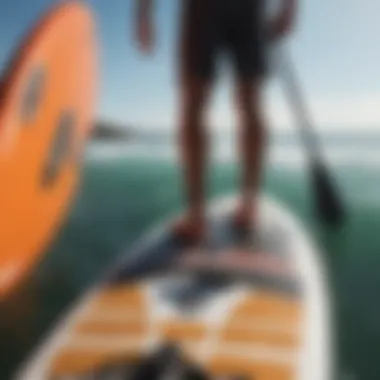
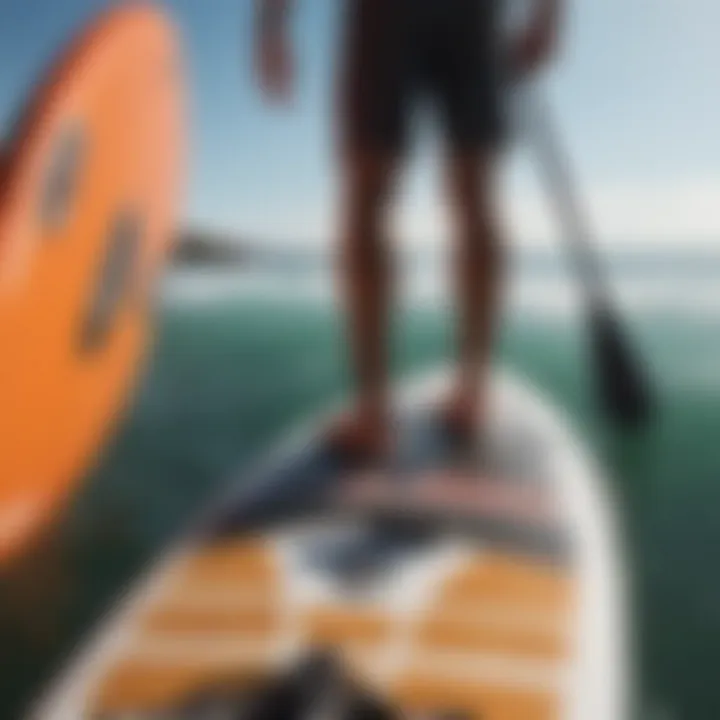
Safety Gear Essentials
Life Vests
When paddling, life vests are an essential safety gear choice that cannot be overlooked. They are vital for ensuring that paddlers remain afloat in case of mishaps. A well-fitted life vest significantly reduces the risk of drowning, making it a common requirement in many areas where water sports occur.
What sets life vests apart is their buoyancy and comfort; many modern vests are designed to be lightweight and less cumbersome, allowing for a full range of motion while paddling. However, it’s important to choose one that meets local regulations and fits properly to avoid discomfort.
Leashes
Leashes are another key element in paddleboarding safety. They connect the paddler to the board, ensuring that if one falls off, the board remains nearby. This minimizes the distance the paddler may need to swim to retrieve their board, which can be crucial in currents or choppy waters.
An important aspect of leashes is their durability; they are usually designed to withstand significant force. However, they can sometimes tangle, which may pose a risk if not managed correctly. Nevertheless, having a leash is typically better than the alternative of chasing a runaway board.
Whistles
Lastly, whistles are a small yet potent tool in any paddler’s safety kit. A whistle serves as an essential signaling device, allowing paddlers to call for help if needed. Given the vastness of water and the potential for sudden changes in conditions, having a whistle within reach can be a game changer during emergencies.
Most whistles are lightweight, easily clipped onto a vest or stored in a pocket, making them accessible and unobtrusive. One drawback, however, is that they are often overlooked by beginners, despite being a simple and effective safety tool.
"In the world of paddleboarding, being prepared can be the difference between a fun day on the water and a hazardous situation. Always pay attention to your gear!"
Overall, understanding equipment is the first step in ensuring an enriching and safe experience in the realm of stand-up paddleboarding.
Techniques for Paddleboarding
Understanding the techniques involved in stand-up paddleboarding (SUP) is essential for any paddler, whether you’re just starting or you have some experience under your belt. Good technique not only enhances your stability and efficiency but also enriches your overall experience on the water. The beauty of SUP lies in its simplicity, yet mastering the technique can greatly improve the enjoyment and safety of your time spent paddling.
Basic Strokes and Maneuvers
Forward Stroke
The forward stroke is the backbone of paddleboarding technique. This stroke propels you forward, but it’s more than just dipping the paddle into the water and pulling it back. The key characteristic of the forward stroke is the rotation of your torso combined with a proper grip on the paddle. A well-executed forward stroke can make your paddleboarding experience smoother and more efficient.
A unique element of the forward stroke is how it incorporates both the upper body and core. As you grip the paddle with both hands, the motion starts from your torso rather than just your arms. This method helps distribute the effort, ultimately reducing fatigue. While a common mistake is leaning too far forward or backward, mastering this stroke delivers significant advantages in speed and stamina.
Turn Techniques
When it comes to navigating tight spots or changing direction, mastering turn techniques is crucial. The main characteristic of effective turn techniques is balance and weight distribution. Whether you're pivoting with a sweep or using a reverse stroke, each method influences how quickly and efficiently you change course.
The unique feature of these techniques lies in the need for precise body positioning. A paddleboarder can either initiate a turn using a wide, sweeping motion with the paddle or by employing a more direct backward stroke—each has its own learning curve and situational effectiveness.
On the downside, some new paddlers may struggle to maintain balance during turns, particularly in windy conditions. However, understanding and practicing these techniques allows for a smoother transition as well as greater control over the board.
Stopping Methods
Stopping methods are critical for safety and skill refinement in paddleboarding. The ability to halt quickly and efficiently can be a lifesaver in crowded areas or when dealing with sudden changes in conditions. Stopping can be achieved through various methods, each with its own key characteristic.
One popular method involves both reverse paddling and thrusting weight back towards the tail of the board. This two-pronged approach helps to slow down and stop in a controlled manner. Another method is the ‘drag’ stop, where you place the paddle in the water alongside the board for immediate resistance. Both methods display unique features that can cater to various situations.
While these techniques can seem straightforward, they require practice to perfect and can be tricky in choppy waters or strong currents. Nevertheless, having effective stopping methods leads to improved confidence and safety on the water.
Advanced Techniques
Cross-Step
Once you’ve got the basics down, the cross-step becomes a pivotal element in enhancing your paddling experience. This advanced technique allows for better weight distribution towards the nose of the paddleboard while maintaining stability. As the wave patterns or your paddling conditions shift, knowing how to employ the cross-step can really help you keep your balance and control.
One major benefit of the cross-step is its ability to optimize speed. By shifting your weight efficiently, you maximize the board's speed without requiring significant physical effort. However, this technique does demand a certain level of practice to feel comfortable and may be less intuitive for beginners.
Downwinding
Downwinding, although often underestimated, offers an exhilarating way to paddle with the wind at your back. The main characteristic of downwinding is the use of wind and waves to your advantage, providing a unique experience that feels almost like surfing. This technique allows for longer rides and improved efficiency on the water.
A distinctive feature of downwinding is the sensation of being propelled forward by the wind and waves, creating a fluid, faster pace. However, it can also come with its challenges, such as unpredictable conditions requiring quick adjustments. For the adventurous paddler, the thrill that comes with mastering downwinding is worth the effort.
Surfing with SUP
Surfing with a stand-up paddleboard introduces a thrilling twist to the paddleboarding experience. The main characteristic of surfing with SUP is the ability to ride waves while standing, providing unique balance and perspective. This technique offers a thrilling combination of both paddleboarding and surfing, which can attract both enthusiasts.
A notable feature of surfing with SUP is the versatility it provides; you can catch waves of various sizes and shapes, similar to traditional surfing. However, mastering this technique requires understanding wave dynamics and timing. For some, it may take time to find the right balance, but once achieved, the sense of accomplishment adds to the allure of paddleboarding.

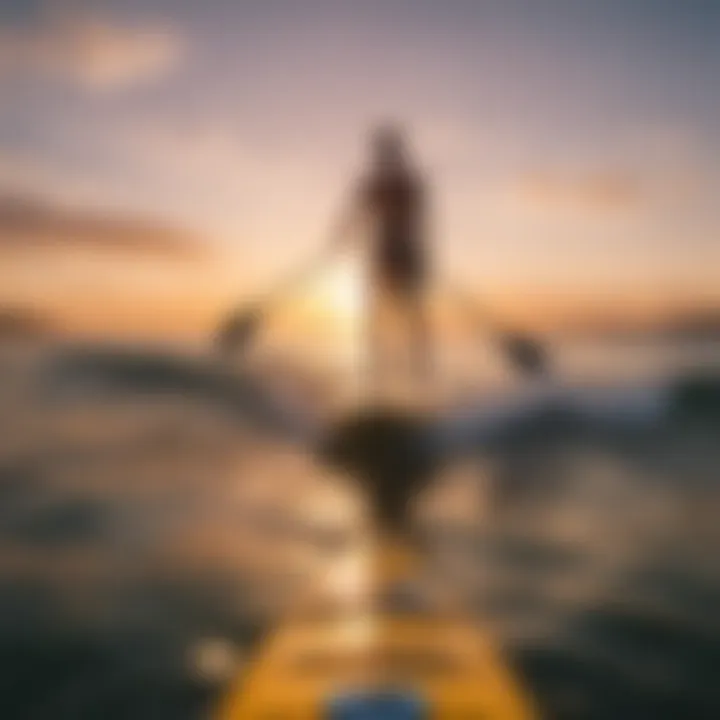
Safety Practices
In the world of stand-up paddleboarding, ignoring safety can be akin to sailing into a storm without a life raft. It’s not just about the thrill of gliding atop the water; it’s about ensuring your adventure doesn’t take a turn for the worse. Without a solid foundation in safety practices, even the most experienced paddler can find themselves in tricky waters. The benefits of knowing what to do in potentially hazardous situations are immense. This section not only addresses practices that enhance your safety but also promotes a culture of awareness and responsibility among paddleboarders.
Recognizing Weather Conditions
Understanding Wind Patterns
Wind patterns can make or break your paddleboarding experience. More than just a breeze, these patterns dictate water conditions and affect your paddling efficiency. For many, calm waters are ideal, but when a wind kicks up, it alters everything.
Understanding which way the wind blows helps you gauge whether it’s safe to go out or if you should stay ashore. A windsock or watching tree leaves helps. If you’re facing headwinds, you may tire yourself out faster than a speeding train. On the flip side, if you’re paddling with a tailwind, you might feel like the wind is literally at your back!
The unique feature of wind patterns is that they can change quickly, so being aware can prevent mishaps. Take the time to study local weather forecasts before you head out, ensuring you’re prepared for those unexpected gusts.
Tide Awareness
Tide awareness is equally crucial for paddleboarders, particularly in coastal areas where tides can shift dramatically. Tides influence water levels, currents, and visibility. Knowing when to paddle is vital, as launching at low tide might leave you scraping the bottom. Conversely, paddling against a strong incoming tide could leave you feeling like you're swimming upstream, literally.
A distinctive characteristic of tide awareness is its predictability. Tide schedules can often be found online or through local resources. This means you can plan your paddle sessions around them, enhancing your experience. However, remember that not all tides are created equal; some channels may become treacherous, especially when combined with strong currents.
Avoiding Hazards
Understanding Water Currents
Water currents can be deceptive. At first glance, a placid lake can hide currents that would make a river adventurous. Understanding these currents means recognizing their direction, strength, and what obstacles they may hide beneath the surface.
Water currents have a unique quality: they can change with the weather and human activity. Being aware of this can help you avoid getting swept away or struggling against a current that feels like climbing a hill. Familiarize yourself with the waterways you intend to navigate, and keep a lookout for signs of fast-moving water.
Identifying Marine Life
The waters are teeming with life, and not all of it is friendly. Identifying marine life is key to enjoying your time on the water without surprises. Some species assert themselves as harmless, while others can wreak havoc on your day.
A distinctive feature of identifying marine life is understanding your local ecosystem. Knowing whether you might encounter jellyfish, sharp-toothed fish, or even friendly dolphins influences your paddleboarding plans. Education on the type of marine life in your paddling area proves beneficial. It helps you avoid potential hazards while respecting the creatures that call the water home.
"Safety in paddleboarding isn’t just about gear or techniques; it’s about understanding the environment and making informed decisions that keep you and the wildlife safe."
Environmental Considerations
With the rise of stand-up paddleboarding as not just a sport but a lifestyle, it becomes crucial to examine the impact our paddling adventures have on the natural world. Understanding and embracing environmental considerations is not only vital for preserving the landscapes we cherish but also for ensuring the sustainability of the sport itself. Whether you're gliding across a tranquil lake or navigating sea currents, being mindful of our surroundings and practices will help keep our bodies of water clean and thriving for generations to come.
Sustainable Practices
Eco-Friendly Gear
One cannot overlook the significance of eco-friendly gear in the realm of paddleboarding. Eco-friendly gear is crafted with materials and methods that minimize environmental harm. Key components of this gear usually include boards made from sustainably sourced materials and paddles produced via processes that focus on reducing waste and pollution.
Choosing eco-friendly gear contributes to a broader goal of promoting sustainability within the paddleboarding community. For instance, boards made from bamboo not only offer durability but also require fewer resources to produce compared to conventional fiberglass options. The unique feature of bamboo is its ability to be light yet strong, thus making it a popular choice among eco-conscious paddleboarders. However, be mindful that such gear may demand a higher initial investment, but the long-term benefits to the environment often justify the extra cost.
Respecting Marine Life
Respecting marine life is another cardinal principle that holds immense importance in the paddleboarding community. By being respectful of the habitats of various aquatic creatures, paddleboarders contribute to maintaining the balance of the ecosystems they navigate. A key characteristic of this respect is operating at safe distances from wildlife, minimizing noise, and avoiding feeding marine animals.
This principle is beneficial as it supports biodiversity and protects delicate ecosystems. The unique feature of respecting marine habitats ensures that paddleboarders can witness and enjoy aquatic life without causing disruptions or harm. The challenge lies, however, in understanding the local marine regulations and being fully aware of sensitive areas that require extra caution. By adhering to this practice, paddleboarders safeguard not just the species present but also enhance their own experiences through awareness and connection to nature.
Impact of Paddleboarding on Ecosystems
As enjoyable as paddleboarding can be, it carries potential effects on ecosystems that should not be brushed aside. Paddleboarding can lead to disturbances in breeding grounds for fish, especially when paddlers venture close to shorelines or through sea grass beds. Additionally, if kayakers and paddleboarders are not careful, they could inadvertently disturb nesting birds or fragile reef systems.
Positive impacts can occur too, however, particularly when paddleboarding promotes awareness and appreciation for nature. Many paddleboarders advocate for clean-up efforts, collecting litter during outings, which helps safeguard the very environments they relish. Thus, while paddleboarding has its pros and cons, the ultimate goal is to engage environmentally conscious practices that mitigate harm while encouraging stewardship of aquatic ecosystems.
Popular SUP Locations
Understanding popular paddleboarding locations is crucial for any enthusiast. The choice of location can dramatically affect the overall experience of stand-up paddleboarding. From serene lakes to the boundless ocean, each environment offers unique elements that cater to different skill levels and preferences.
Lakes and Rivers
Paddling on lakes and rivers can be an excellent way for beginners to dip their toes into stand-up paddleboarding. The relatively calmer waters provide a safer environment where one can focus on developing their skills. Lakes often have scenic views, making them not only a great practice ground but also a wonderful way to connect with nature.
Considerations when choosing a lake or river include:
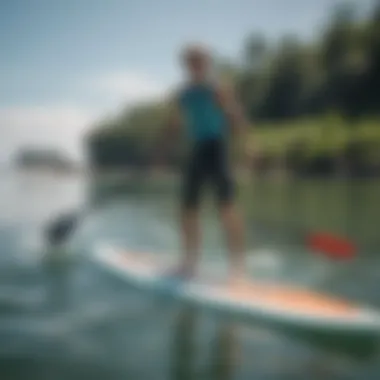
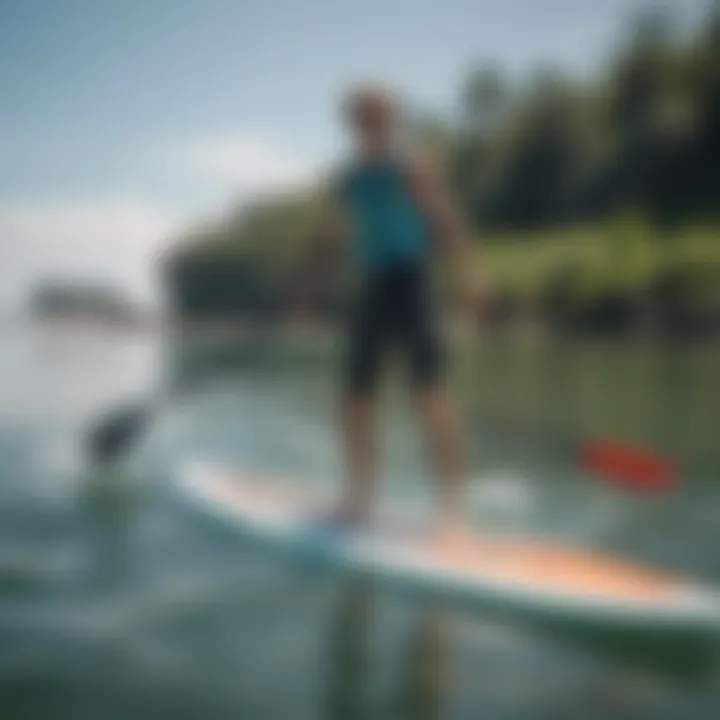
- Water Conditions: Always check the current of rivers; fast flows make for a challenging experience.
- Accessibility: Some locations may lack proper launching points or adequate parking.
- Local Regulations: Be aware of any restrictions regarding paddleboarding in certain areas; this varies greatly between states and municipalities.
Ocean Spots
The ocean presents a thrilling option for those seeking a bit of adventure. However, it brings its own challenges.
Beginner-Friendly Beaches
Beginner-friendly beaches are often characterized by their gentle waves and sandy bottoms. Locations like Waikiki Beach in Hawaii or Coronado Beach in California allow novice paddlers to enjoy the ocean without being overwhelmed by strong currents or high waves. They offer an opportunity to practice balance and technique without the stress of navigating rough waters.
- Key Benefits: These beaches typically have lifeguards on duty, making them a safer choice for newbies; plus, friendly locals often share tips and insights.
- Unique Features: Often surrounded by stunning landscapes, beginner-friendly beaches can provide a visual feast while you're paddling.
However, a drawback could be overcrowding, especially during peak seasons. This can make it difficult to find space to practice.
Challenging Surf Areas
For the more adventurous, challenging surf areas represent the epitome of paddleboarding thrills. Locations like Malibu or the North Shore of Oahu offer intense waves that can test one’s skill and determination. They attract experienced paddlers looking for their next adrenaline rush.
- Key Characteristics: These spots are known for their powerful waves, which can change quickly based on weather conditions.
- Advantages: Riding the waves using a paddleboard can offer an exhilarating experience unlike any other. The satisfaction of mastering a challenging surf can also be unmatched.
However, these locations are not for the faint-hearted or inexperienced. The risks of wipeouts and exposure to rough water mean safety should always be a priority. Understand your limits and perhaps consider taking lessons before tackling these more demanding spots.
"The ocean is a master instructor; it teaches patience, humility, and respect like nothing else."
In summary, whether you prefer the tranquility of lakes and rivers or the thrill of ocean waves, knowing where to go is key to enhancing your paddleboarding experience. Each type of location offers its unique charm, challenges, and community, contributing to the rich tapestry of the paddleboarding culture.
Maintaining Your Equipment
Maintaining your paddleboarding gear is crucial for several reasons. Not only does proper maintenance extend the lifespan of the equipment, but it also ensures safety during your paddleboarding adventures. Gear that is well-kept performs better on the water while reducing the chances of accidents or malfunctions. Furthermore, taking care of your equipment can enhance your overall experience, allowing you to focus on enjoying the sport rather than worrying about whether your gear can hold up.
Cleaning Techniques
Regular cleaning of your paddleboard and accessories is an integral part of their maintenance. Saltwater, sand, and grime can accumulate quickly, particularly if you're frequenting ocean spots.
Here are some practical steps to keep your equipment in top-notch condition:
- Rinse After Each Use: After every outing, give your paddleboard a good rinse with fresh water. This is especially important if you’ve been in saltwater. Leaving salt on the surface could corrode your board over time.
- Mild Soap and Cloth: For deeper clean, use a light detergent mixed with water. A soft cloth works better than a rough scrub that can scratch the surface.
- Drying: After rinsing, it’s best to dry your board with a towel to prevent water spots and mildew.
- Inspect: Always take a moment to check for any signs of damage or wear during cleaning. Small nicks or blemishes can turn into bigger issues if left unnoticed.
By keeping up with these cleaning practices, you not only protect your gear but also maintain its aesthetics.
Storage Practices
Proper storage plays a significant role in prolonging the life of your paddleboarding equipment. Here are key considerations to keep in mind:
- Keep It Cool and Dry: Avoid leaving your paddleboard in direct sunlight for long periods. UV rays can degrade the materials, leading to cracks or fading. Ideally, store it in a cool, dry location.
- Use a Board Bag: Invest in a protective bag for your board. This adds an extra layer of protection against scratches and impacts.
- Store Upright or Flat: Depending on the design, you might store your board either vertically or horizontally. Just make sure to avoid placing it under heavy items which could warp it over time.
- Secure Your Accessories: Leashes, paddles, and safety gear should also have proper homes. Use racks or bins to prevent tangling and damage.
Maintaining your equipment through good cleaning and storage practices will ultimately keep your paddleboarding journey exciting and worry-free. Plus, when you take pride in your gear, it adds an extra layer of joy to every outing.
"Good gear care is an investment in a seamless paddleboarding experience."
For a deeper dive into gear maintenance, you can join communities on platforms like reddit.com or check out groups on facebook.com for tips from fellow enthusiasts.
Community and Culture
Stand-up paddleboarding (SUP) transcends the mere act of gliding across water; it is deeply entwined with a vibrant community and culture. The essence of this sport is often found in the connections formed between enthusiasts, which adds layers to the paddleboarding experience. Engaging with others not only enhances the fun but also cultivates opportunities for learning and sharing knowledge, crucial for anyone looking to improve their skills.
Connecting with Other Enthusiasts
Clubs and Groups
Clubs and groups serve as a cornerstone for the SUP community, offering a more structured way for enthusiasts to connect. One prominent aspect of these clubs is the shared passion for paddleboarding. Because who wouldn’t want to engage with fellow paddleboarders who share their love for it?
- Benefits: Joining a club can provide access to organized events, group outings, and tutorials led by experienced paddlers. It’s often within these clubs that friendships bloom and paddling partners are found, making it easier to hit the water regularly.
- Other Features: Many clubs also emphasize camaraderie, often organizing social events that go beyond paddling itself. Whether it’s a barbecue after a paddle or a workshop on safety, these gatherings foster a sense of belonging.
- Considerations: However, it’s worth mentioning that some clubs might have fees or strict membership guidelines, which can be a barrier for some.
Online Forums
In today’s digital age, online forums have emerged as a valuable resource for many paddleboarders globally. These platforms serve as hubs for discussion and advice, making them particularly appealing for those unable to connect in person.
- Key Characteristic: They provide a space for individuals to ask questions, share experiences, and discuss everything from gear reviews to local paddle spots. It’s like having a global chat with like-minded individuals!
- Unique Feature: The asynchronous nature of online forums means that enthusiasts can engage at their own convenience. Users can browse threads, catch up on discussions, and post queries without the constraints of time zones or schedules.
- Advantages vs Disadvantages: While these forums can be incredibly informative, the downside is that sometimes misinformation can spread, thus it's important to verify advice through reliable sources.
Events and Competitions
Events and competitions serve as a litmus test for the talent within the SUP community. These gatherings not only draw in top-tier paddlers but also foster a competitive spirit that motivates all participants to elevate their skills. From local races to international competitions, these events encompass a wide range of categories suitable for various skill levels, promoting inclusivity.
Being part of such events can be a game changer. They allow paddlers to witness techniques from some of the best while also providing an opportunity to showcase one’s own prowess. Moreover, these competitions often emphasize safety and environmental awareness, aligning perfectly with the culture that paddleboarding promotes.
In summary, the importance of community and culture in paddleboarding lies in the support and relationships that can significantly enrich one’s experience, making it not just about the sport but a way of life.















